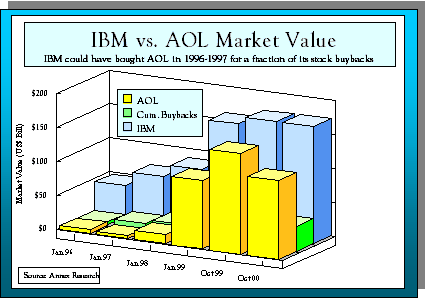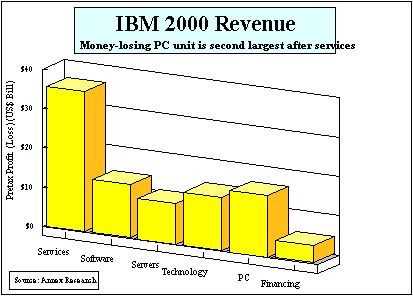

|Annex
Research | Annex Bulletins | Quotes | Workshop | Feedback | Clips | Activism | Columns
![]()
The copyright-protected information contained in the ANNEX BULLETINS is a
component of the Comprehensive Market Service (CMS). It is intended for the exclusive use
by those who have contracted for the entire CMS service.
INDUSTRY TRENDS
A
“Big Blue” Breakup Revisited, Nearly Five Years Later
What’s
IBM Really Worth
Today?
Planned AT&T Breakup Renews Interest in an Old Idea about IBM
PHOENIX, Nov. 2 – Nearly five years ago, we first started toying with the idea of an IBM break-up. The reason? We though the IBM stock was undervalued. Having been used to thinking of IBM for decades as a hardware company, Wall Street seemed unwilling or unable to give the Big Blue credit for its new “crown jewels,” such as services, for example. Breaking up IBM would force the investors to evaluate each unit on its own merit relative to its peers, we reasoned. The result would be a smaller Big Blue, but a company whose sum of the parts would produce a shareholders’ value that was more than double the IBM market cap at the time.
Then a British business media editor’s interest in running a story about an IBM break up made us do some serious research into it. By January 1996, our work was finished and published in the “Break-up IBM!” Annex Bulletin (see Annex Bulletin - 96-19, Computer Business Review [UK], Associated Press, CNN, Newsweek, New York Times, Worth magazine, Los Angeles Times, the Financial Post [Canada], Bulletin [Australia] and other major media reports about it, which followed later in 1996).
But in August 1996, Lou Gerstner, the IBM boss, said he thought the break-up was “a dumb idea” (see “Louis XIX of Armonk”). And opted instead to spend billions of dollars stuffing Wall Street’s pockets through stock buybacks.
It worked. Exceedingly well. By early 1998, the IBM market cap had already surpassed what we felt was a fair market value of the sum of the IBM parts (see the May 1998 chart on the next page). At its peak in July 1999 ($139), and again close to it in August of this year ($132), Wall Street proved once again, that IBM’s lackluster business fundamentals were no obstacle to its newfound love affair with the Big Blue, greased by the $37 billion and counting of IBM stock buybacks.
And then the bottom fell out of the IBM stock in late October, as the company reported its usual mediocre results (which actually “weren’t really all that bad,” as we put it in the Annex Bulletin 2000-23, Oct. 18, 2000). This time, however, Wall Street seems to have had enough of IBM’s “smoke and mirror” games, and trashed the stock to the tune of $37 billion to $42 billion of shareholders’ value that was wiped out in a single day.
 Then came the announcement of the planned AT&T
break up (see Annex
Bulletin 2000/24, Oct. 26, 2000), renewing the interest in an old
Annex Research idea. This
time, it was a major U.S. business media editor who asked us if we would
reevaluate our idea of the IBM break-up, and update the numbers to the
current time frame and the market place.
We did. What follows
is our summary conclusion.
Then came the announcement of the planned AT&T
break up (see Annex
Bulletin 2000/24, Oct. 26, 2000), renewing the interest in an old
Annex Research idea. This
time, it was a major U.S. business media editor who asked us if we would
reevaluate our idea of the IBM break-up, and update the numbers to the
current time frame and the market place.
We did. What follows
is our summary conclusion.
Summary
Would breaking up IBM make sense today, we were asked? Yes and no. Yes - if the company is to survive in the long run. No - if the stockmarket valuation is the primary driving force behind it, as it was five years ago.
For, after analyzing and comparing the six logical parts into which IBM could be broken up (Services, Software, Servers, Technology, PC and Finance companies) to the peer companies in their respective IT sub-markets, the bottom line is that a vertically integrated IBM is still overvalued today.
As you can see from the charts and tables in this Annex Bulletin, we figure that the sum of the parts of a broken up IBM would yield a fair market value of about $150 billion, or $85 per share. That compares to the IBM market cap as of Oct. 31 (i.e., after the Oct. 18 devaluation) of $173 billion or $98.50 per share. Which means that in the current bubble market, even a deflated IBM is still one of the bigger bubbles waiting to be burst at some point in the future.
So if the Big Blue were to be broken up now, it would have to be for operational, not financial reasons - survival being one of them, especially for the hardware parts of the Armonk empire.
But don’t expect the current IBM management to carry it out. Breaking up was “a dumb idea,” remember?
Well, we’ll let the marketplace have the final word on that. For, had IBM split itself up five years ago, and then let its offspring spend $37 billion or more on acquisitions of various dot.coms or other promising future IT leaders, instead of squandering it on Wall Street bribes, Armonk could have been a proud owner today of an AOL, for example. With a Netscape and Time-Warner inside. Or of thousands of future would-be AOLs or Yahoos.
 Back
in January 1996, for example, AOL’s market cap was “only” $6.5
billion. One year later, it
was even lower - $5.4 billion. By
that stage, of course, IBM had already spent about $10.7 billion on stock
buybacks.
Back
in January 1996, for example, AOL’s market cap was “only” $6.5
billion. One year later, it
was even lower - $5.4 billion. By
that stage, of course, IBM had already spent about $10.7 billion on stock
buybacks.
Had the company had the foresight to invest at least a fraction of that money into future winners, such as AOL, it would have been sitting fat and happy by October 1999, when AOL market cap was about $150 billion - roughly what IBM is worth today.
Instead, IBM’s only major acquisitions have been that of Lotus in June 1995 and of Tivoli in 1996. Which boosted IBM’s presence in the “has been” market - the large corporations’ world, rather than in the future growth areas - small companies and consumer markets.
That was some “vision.” That was some “leadership.” That was “some bright idea.”
But as President Dwight Eisenhower once said, “we’ve flogged this horse enough. Let’s get a new one.”
IBM shareholders may wish to do the same. Or dismount altogether.
Happy bargain hunting!
Bob Djurdjevic


